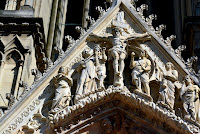 Saturday, October 3 -- We have many fond memories of France, and the wine is one of them. So, it seems appropriate to memorialize the bottles we encountered during our travels in Burgundy and Alsace.
Saturday, October 3 -- We have many fond memories of France, and the wine is one of them. So, it seems appropriate to memorialize the bottles we encountered during our travels in Burgundy and Alsace.
These are not all the wines we tasted, but they are the ones of which I took photographs while we were confronting them.

September 20 lunch in Beaune
 |
| September 21 lunch - a good white Domaine St. David, |

September 22, 2015
Between Dijon and Santenay one can take La Route Touristique des Grands Crus and discover the classic Burgundy wines with their aromatic richness and their purple or golden color. This legendary itinerary passes through 31 typically Bourguignon towns and villages, and opens the way to a world-renowned winegrowing region.

September 23, 2015 in Puligny-Montrachet
As soon as you leave Dijon, you are on the Côte de Nuits with its gently sloping plots. This is the cradle for many Grand and Premier Cru wines. Nicknamed the Champs-Elysées of the Bourgogne region, in parts, it is no more than 300 meters wide, and brings together a host of world-famous climats. The word does not refer to meteorology but in this part of France is used to describe the Burgundian vineyard terrior.
To the south of Ladoix-Serrigny, the trail continues on the Côte de Beaune, with its gentle slopes and Bourgogne traditions. Take the time to visit some cellars or maisons de négoce – all year-round the winemakers are willing to share their expertise and lore about the Bourgogne lands with you. If you are lucky, they will invite you to taste their wines too.
 |
| September 25 at Chateaux Chassagne-Montrachet |
During a trip along La Route des Grands Crus the Vignobles and Decouvertes label will guide you to the region’s must-see places.
In Dijon, for example, we found that you can follow the Owl Trail (marked with brass owls in the sidewalks) which will lead you on a walking tour through 22 of the city’s most historic sites.
 |
| September 25 at Chateaux Chassagne-Montrachet |
Over 23 kilometers between Beaune and Santenay, a well-marked véloroute will lead you through Burgundian countryside. Or you can travel La Route des Grands Crus on horseback, by little train, on a Solex or a gyropod (a small one-man electric vehicle on which one stands upright).
 |
| September 25 at Chateaux Chassagne-Montrachet |
Or, why not fly overhead in a hot-air balloon or take a helicopter ride? Along this exceptional path, the locals will also delight in sharing their festivities with you. All year round, from village to village, there is much to savor along these wine soaked roads.






































